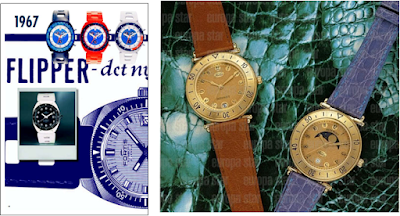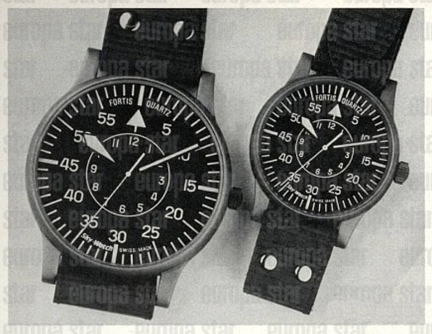By Bruce Shawkey
Walter Vogt (left), then 25, founded the company in 1912 in Grenchen. Though the company is known for its Flieger pilots' watches and chronographs, it was first a pioneer in the marketing and distribution of automatic watches. In 1926, Vogt met John Harwood at the Basel Fair where Harwood exhibited his new invention of a full rotor automatic watch. Vogt was fascinated by Harwood's invention and believing that automatic watches were the future, he offered to partner with Harwood in bringing his watch to a larger market. Thus began Fortis' distribution rights for the Harwood automatic watch, pictured below, at right.

Harwood and Vogt's partnership flourished, with a portion of the Fortis factory devoted to making Harwood watches. The partnership continued with the "Autorist," (below, left) that reportedly stayed wound by the flexing of the wrist. Fortis claims they mass produced the Autorist, but I've never seen one in the flesh, only in advertisements. The design was ill-fated, owing to the fact that the small flexing motions of the wrist were not sufficient to keep the watch wound. But it was a very creative attempt, and surely a grail watch by collectors who specialize in early automatic watches. If anyone has an image of one, I would love to see it and share with my readers. Send the image to bruce.shawkey@gmail.com.
Harwood eventually separated from Fortis to become the Perpetual Self-Winding Watch Company. Falling victim to the Great Depression, Rolex reportedly scooped up many of Harwood's patents that went into Rolex's Perpetual movement. In the 1950s, some of Rolex's ads indicated they had invented the automatic wristwatch. John Harwood sued them and won. This ad pictured below at right is the formal (court-ordered) apology that Rolex printed in 1956 and to my knowledge the only time Rolex apologized for anything!
As an aside, in the late 1980s, Fortis created a limited edition tribute watch to the original Harwood (round) automatic.
 |
| Rolex's court-ordered apology to John Harwood |
Fortis was also one of the first companies to bring a commercially successful wrist chronograph to market in the 1930s. It is chronographs that Fortis currently promotes the most at its website.
In 1940, Fortis released its first water-resistant watches: the Fortissimo. An example is pictured below at right. Fortis eventually produced a number of watches in the Fortissimo line, ranging from simple three hand dress and field style watches with A. Schild movements, to chronographs with Landeron movements. What the actual water resistance rating of the Fortissimo models was is unclear. The '40s and '50s were still the "wild west years" of advertising, with little regulation requiring companies to back up stated claims with fact. Most water-resistant watches in this era were simply marketed as “waterproof.”
At this point, we’ll take a break and look at some Fortis advertising through the years.


In 1956, Fortis won the first chronometer award conferred by the Swiss institute for the world's first water-resistant mechanical alarm: the Manager, shown left.
In 1961, Rolf Vogt, son of the founder, traveled to America and presented to NASA a Fortis "Spacematic AR" (All Risks) designed in recognition of the efforts and daring of the first astronauts. Those first Spacematic watches (example shown at right) did not make it into space because of the challenge of a rotor oscillating in zero gravity. But it is still a cult classic among watch collectors.
Fortis produced many conventional wristwatches -- both manual wind and automatic -- from the '30s well into the 1960s. A few of those are pictured below.
 |
| L to R: A 1957 model with date; 1957 Eden Roc; three models from 1965, including the Skylark at extreme left. |
 |
Tuxedo, Tuxedo II, and Skylark models from a 1969 catalog. |
By the end of the 1950s, the Fortis logo underwent its first and quite radical redesign. The majestic crown and curved letters were replaced by a modern contemporary brand logo, reflective of the progress of the 1950s. Various combinations of the old and new logo can be found on the dials of such successful models as the Eden Roc, Streamline, Marine Master, or Performance, .
By the late '60s and early '70s, Fortis was feeling the pressure of the quartz invasion and was looking to reinvent itself. Various attempts such as "Hedonist" and "Flipper," with their colorful cases reminiscent of Swatch watches and utilizing quartz movements were only partially successful (see below at right).
 |
| Flipper and two Hedonist models, right |
Fortis needed something new, and they found it in something old: the Flieger and Pilot models introduced nearly a half century before. These “new” models, introduced in the late '80s and early '90s, were the complete repudiation of the quartz invasion, with their simple lines, cases up to 40mm in diameter, and mechanical movements, indicative of the no-frills designs of the aviation watches of World War II (see below, left).
 |
| First Flieger models, circa late '80s, early '90s |
In 1994, Fortis released a chronograph (extreme right) that became the Official Cosmonauts Chronograph. It was perhaps Fortis’ most iconic, well known watch. Fortis themselves weren’t aware of this when they released it. It was a variation on their popular Flieger chronograph with a steel tachymeter bezel. ROSCOSMOS, the Russian space agency, invited Fortis to send several of the chronographs to them for testing and subjected them to six months of rigorous trials. The watches passed with flying colors and received a certification from the agency. The Official Cosmonauts Chronograph would go on to fly dozens of missions and thousands of hours throughout the 1990s and early 2000s on MIR and later the International Space Station. It’s widely accepted that the Cosmonauts Chronograph has most likely spent the most actual hours in spaceflight of any watch.
The company in 2012 produced a marvelous 88-page full-color 100th anniversary book which, as of September 2022, is still available at https://docs.wixstatic.com/ugd/81980a_5836c93dcbfb4d628141469f81e77ad3.pdf.
In 2017, the company filed for a debt restructuring moratorium, and shortly afterward, the company was taken over by Jupp Philipp, a Fortis enthusiast, who has an unlikely background in the fruit business.
The current model lineup, in my opinion, is rather like a fruit salad and reflective of Philipp’s background and includes:
* The Stratoliner, a salute to the 1992 model, now developed in cooperation with the Swedish Space Corporation to explore the stratosphere, the layer of the earth's atmosphere extending to about 32 miles (50 km) above the earth's surface and containing the all-important ozone layer, without which life on earth as we know it wouldn't be possible;
* Marinemaster, a rugged timekeeper made of recycled steel and black resin for the outdoor adventurer in 40 and 44mm case sizes;
* Flieger, in time-only and chronograph models, remaining true to the designs of the first Flieger models introduced in 1987;
* Official Cosmonauts, a salute to the company's ties to the Russian space program, but now with two models affiliated with the Austrian Space Forum; and
* Aeromaster, for more than 20 years the collection has been aimed as pilots' watches. It's a rather hodgepodge collection of alarm chronographs, chronograph, and day-date models.
I'm not sure where the company is headed. Surely, it is a far cry from the days of the Harwood automatic. Now, solely owned, with a CEO whose roots are in the fruit business, I suppose anything is possible.
 |
L to R: Current (2022) models: Stratoliner; Marinemaster; Flieger chronograph.
 |
L to R: Current (2022) models: Official Cosmonauts; Aeromaster. |
Here are some more Fortis images from the mid-1960s:








